Aggregate plays a filling role in concrete and stabilizes the concrete volume, which generally accounts for about two thirds of the concrete volume. The aggregate should firstly ensure that the quality of the concrete meets the requirements and then take the material locally (or nearby) to minimize the cost as far as possible.
The aggregate in concrete is mainly composed of sand (fine aggregate) and stone (coarse aggregate). The change of the fineness modulus of sand and the quality of stone will lead to the change of concrete aggregate quality.
In addition to the change of cement, water quality, water-cement ratio, curing temperature and humidity, concrete age and construction method, it will cause a change in concrete quality. Therefore, how should we ensure the quality of concrete?

Concrete: mainly composed of sand (fine aggregate) and stone (coarse aggregate)
1. Influence of sand fineness modulus on slump and bleeding rate
| Types | Fineness modulus | Mean grain size |
| Coarse sand | 3.0-3.2 | >0.5 mm |
| Medium sand | 2.3-2.9 | 0.35-0.5 mm |
| Fine sand | 2.2-2.6 | 0.25-0.35 mm |
| Super fine sand | <2.2 | <0.25 mm |
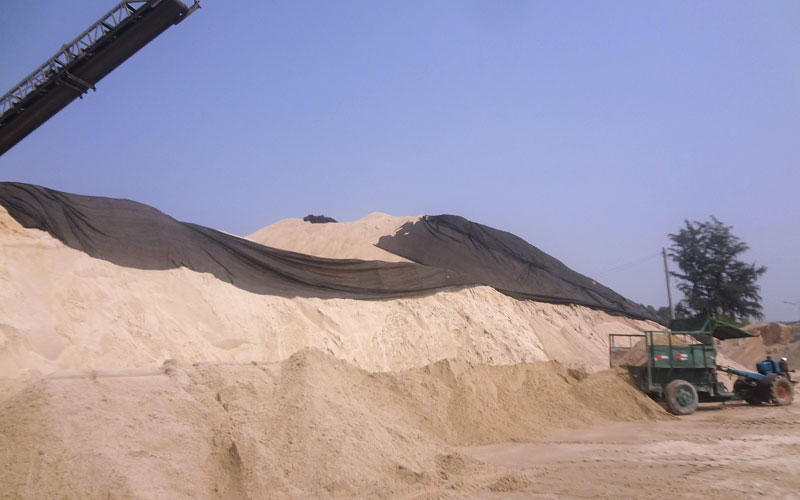
Sand on site
If the fineness modulus of sand decreases, which means the sand becomes finer and its surface area increases, the slurry remained to lubricate the sand surface will decrease, therefore, the concrete slump decreases.
Coarse sand has a small surface area and poor water retention, so coarse sand concrete, being prone to bleeding and segregation, looks rough and has poor workability and viscosity.
Distinct from coarse sand, fine sand concrete has good water retention, low bleeding rate, good workability and is not easy to segregate.
2. Influence of sand fineness modulus on concrete mix
When the sand in production becomes finer, the concrete slump will decrease and the construction become more difficult.
On the contrary, when the sand fineness modulus becomes larger, the concrete will have relatively larger slump, worse water retention with the bleeding and segregation being likely to occur, and it is even difficult to be vibrated and compact (insufficient mortar).
Under the condition of constant water-binder ratio, the sand ratio should be adjusted properly to keep the working property of concrete mixture unchanged when the sand fineness modulus changes.
Generally speaking, if the fineness modulus changes by 0.2, the sand rate should change by 1%~2%. While adjusting the sand rate, the number of admixtures should be increased or decreased appropriately and the proportion of water consumption should not be changed.
3. Effect of sand fineness modulus on concrete strength
In the production process, when the sand becomes finer, the slump of the concrete mixture will be small. To ensure the predetermined slump, a simple but always wrong method is often adopted, that is to add more water.
This will easily cause the illusion that the strength of fine sand concrete is lower than that of coarse sand concrete. In fact, as long as the water-binder ratio is kept constant, the sand thickness will not affect the concrete strength.
4. Mud content in the sand
If the sand contains lots of mud, the concrete will have larger water demand, poor plastic retention, more shrinkage, decreased concrete strength, and is easy to crack.
Therefore, the mud content in the sand should be controlled at less than 3% (C30~C50). The mud content requirement of the high-strength concrete is even higher.
5. Selection of stones (pebble concrete vs crushed stone concrete)

Selection of stones
The rough surface of coarse aggregate is beneficial to the interfacial strength of cement slurry and aggregate.
According to many years of testing, the pebble concrete, containing more weathered stone, has lower crushing index compared with crushed stone, and smooth surface and low interfacial strength, so the strength of the pebble concrete will be 3~4 MPa lower than that of the crushed concrete with the same ratio.
6. Gradation of stone particles
There are no particles less than 10 mm can be seen on the stone pile during the production process, and the pebbles change from continuous grading of 5 ~ 25 mm or 5 ~ 31.5 mm to the single gradation of 10 ~ 25 mm or 10 ~ 31.5 mm.
It should be adopted to increase 10% ~ 20% of small stones with the particle size of 5 to 10 mm instead of gravels or increase the sand rate by 2%, and at the same time increase the concrete admixture by 0.1% ~ 0.2% to adjust the concrete mix.
7. Mud content of the stone
The mud content of the stone should not exceed 0.5%. If mud is found on the surface of the stone during the production, the admixture should be increased by 0.1% to 0.3% to prevent slump loss caused by the adsorption of the admixture.
The greater the mud content, the greater the number of admixtures should be added, and vice versa.
8. Needle-like particles content
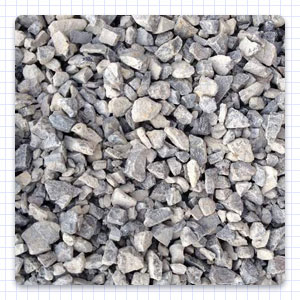
The content of the needle-like stones should meet the requirements of national or industry specifications.
When needle-like particles in the stone are significantly increased, the sand rate should be appropriately increased by about 2% and the number of concrete admixtures increased by 0.1% to 0.2% to keep the water consumption unchanged.
9. Stone size
During the production process, if the stone particle size is found to change, the sand rate should be adjusted accordingly to prevent the occurrence of concrete aggregate exposure, which can also lead to concrete segregation, pumping pipe blockage, etc.
10. Stone powder content
When the supply of stones is tight, the content of stone powder often increases. If the content of the stone powder increases, the sand rate should be appropriately reduced by about 3% and the admixture increased by 0.1% to 0.2% to prevent excessive slump loss of the concrete caused by the increase of stone powder.
11. Content of weathered stone
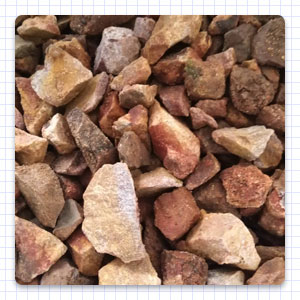
In the process of stone mining, sometimes some weathered stones with large water absorption rate and low crushing value in the surface layer will be brought in.
They will melt away when wet, and sometimes they will be broken by the sun.
In general, the water consumption of concrete with 30% weathered stones is greater than that of ordinary concrete, which is about 40 ~ 60 kg/m3.
It is generally recommended that the use of weathered stone aggregate is strictly prohibited, and when it is forced to use, it should be combined with qualified gravel to reduce its harmful effects.
12. Stones that are likely to have an alkali-aggregate reaction (AAR)
If the current coarse aggregate has the potential of alkali-aggregate reaction, for the sake of caution, the concrete construction should be suspended.
After the inspection by the authoritative testing agency, the next decision can be made, including replacing the coarse aggregate, using it with confidence, or taking reliable measures.
13. Cement
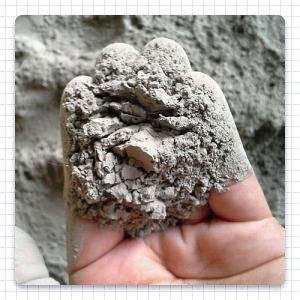
The amount of cement used for ready-mixed concrete should not be larger than 540 kg/m3, and different types of cement should be selected according to different usage regulations.
It is not suitable to select Portland cement for the concrete with large volume prone to occur cracks caused by temperature difference. The cement with high water retention performance can evenly distribute the voids in the concrete.
14. Water quality
Both tap water and drinkable water can generally be used to mix concrete. Water containing impurities will reduce the adhesive property of cement and the strength of concrete.
Therefore, industrial wastewater containing fat, vegetable oil, sugar, acid, etc. cannot be used to mix concrete. See Standard Active Standard ASTM C1602 for details.
15. Water-cement ratio
The water-cement ratio directly affects the strength of concrete. When the water-cement ratio is relatively large, there are relatively few cement particles in the concrete mixture, and the distance between the particles is large.
The colloid produced by hydration is not enough to fill the gaps between the particles, in addition to the interspaces left due to excess evaporation, which reduces the strength of concrete.
However, an excessively low water-cement ratio results in too little water, making cement hydration difficult, so some cements cannot be fully hydrated, which is not conducive to strength improvement.
16. Curing temperature and humidity
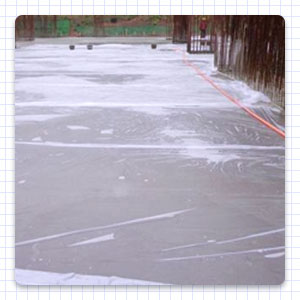
Temperature and humidity act on concrete by influencing the hydration process of cement.
If the curing temperature is high, the early hydration speed of cement will be fast and concrete strength in the early age will be high.
The concrete temperature at the early stage of hardening has an effect on its strength at the later stage. The higher the initial curing temperature, the lower the strength growth rate at the later stage.
With proper humidity, cement hydration and hardening can proceed normally and concrete can be fully strengthened.
If the humidity is not enough, the concrete will lose water and dry, affecting normal hydration, which not only seriously reduces the concrete strength, but also affects its durability by loose concrete structure or shrinkage cracks due to incomplete hydration.
17. Concrete age
Under normal curing temperature, the strength of concrete will increase with its age. In the first 7 to 14 days, its strength will increase rapidly, then gradually slow down, and it will be even slower after 28 days.
18. Construction method
When mixing concrete, mechanical mixing is more uniform than manual mixing, which is beneficial to the concrete strength in the later period. For a mixture with a small water-cement ratio, it is advisable to use the forced mixer.
Under the condition of the same mixture ratio and compact molding, the compressive strength of the concrete mixed by machine is about 10% higher compared with manual mixing.
When pouring concrete, mechanical vibration should be used to facilitate the compaction of the concrete, which is particularly significant for concrete with a small water-cement ratio.

